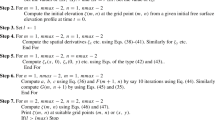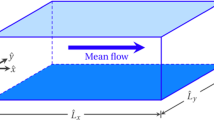Abstract
Horizontal shear motion of a homogeneous fluid in an open channel is considered in the approximation of the shallow water theory. The main attention is paid to studying the mixing process induced by the development of the Kelvin–Helmholtz instability and by the action of bottom friction. Based on a three-layer flow pattern, an averaged one-dimensional model of formation and evolution of the horizontal mixing layer is derived with allowance for friction. Steady solutions of the equations of motion are constructed, and the problem of the mixing layer structure is solved. The bottom friction produces a stabilizing effect and reduces the growth of the mixing layer. Verification of the proposed one-dimensional model is performed through comparisons with available experimental data and with the numerical solution of the two-dimensional equations of the shallow water theory.
Similar content being viewed by others
References
C.M. Ho. and P. Huerre, “Perturbed Free Shear Layers,” Annual Rev. Fluid Mech. 16, 365–424 (1984).
W. S. J. Uijttewaal, “Hydrodynamics of Shallow Flows: Application to Rivers,” J. Hydraul. Res. 52, 157–172 (2014).
G. H. Jirka, “Large Scale Flow Structures and Mixing Processes in Shallow Flows,” J. Hydraul. Res. 39, 567–573 (2001).
B.L. Rhoads. and A. N. Sukhodolov, “Lateral Momentum Flux and Spatial Evolution of Flow within a Confluence Mixing Interface,” Water Resources Res. 44, W08440 (2008).
V. Chu and S. Babarutsi, “Confinement and Bed-Friction Effects in Shallow Turbulent Mixing Layers,” J. Hydraul. Eng. 114, 1257–1274 (1988).
G.L. Brown. and A. Roshko, “On Density Effects and Large Structure in Turbulent Mixing Layers,” J. Fluid Mech. 64, 775–816 (1974).
W. S. J. Uijttewaal and R. Booij, “Effects of Shallowness on the Development of Free-Surface Mixing Layers,” Phys. Fluids 12, 392–402 (2000).
R. Booij and J. Tukker, “Integral Model of Shallow Mixing Layer,” J. Hydraul. Res. 39, 169–179 (2001).
B.C. van Prooijen and W. S. J. Uijttewaal, “A Linear Approach for the Evolution of Coherent Structures in Shallow Mixing Layers,” Phys. Fluids 14, 4105–4114 (2002).
M.S. Ghidaoui. and J. H. Liang, “Investigation of Shallow Mixing Layers by BGK Finite Volume Model,” Int. J. Comput. Fluid Dyn. 22, 523–537 (2008).
H. Liu, M. Y. Lam, and M. S. Ghidaoui, “A Numerical Study of Temporal Shallow Mixing Layers Using BGK-Based Schemes,” Comput. Math. Appl. 59, 2393–2402 (2010).
G. Kirkil, “Detached Eddy Simulation of Shallow Mixing Layer Development between Parallel Streams,” J. Hydro-Environ. Res. 9, 304–313 (2015).
D. J. Benney, “Some Properties of Long Nonlinear Waves,” Studies Appl. Math. 52, 45–50 (1973).
A.A. Chesnokov. and V. Yu. Liapidevskii, “Wave Motion of an Ideal Fluid in a Narrow Open Channel,” Prikl. Mekh. Tekh. Fiz. 50 (2), 61–71 (2009) [J. Appl. Mech. Tech. Phys. 50 (2), 220–228 (2009)].
A.A. Chesnokov, V. Yu. Liapidevskii, “Shallow Water Equations for Shear Flows,” Notes Numer. Fluid Mech. Multidisciplinary Design 115, 165–179 (2001).
V. Yu Liapidevskii and V. M. Tehukov, Mathematical Models of Long Wave Propagation in an Inhomogeneous Fluid (Izd. Sib. Otd. Ross. Akad. Nauk, Novosibirsk, 2000) [in Russian].
V. Yu. Liapidevskii and A. A. Chesnokov, “Mixing Layer under a Free Surface,” Prikl. Mekh. Tekh. Fiz 55 (2), 127–140 (2014) [J. Appl. Mech. Tech. Phys. 55 (2), 299–310 (2014)].
V. Yu. Liapidevskii and A. A. Chesnokov, “Horizontal Mixing Layer in Shallow Water Flows,” Izv. Ross. Akad. Nauk, Mekh. Zhidk. Gaza, No. 4, 91–107 (2016) [Fluid Dyn. 51 (4), 524–533 (2016)].
L. V. Ovsyannikov, “Two-Layer’ Shallow-Water’ Models,” Prikl. Mekh. Tekh. Fiz. 20 (2), 3–14 (1979) [J. Appl. Mech. Tech. Phys. 20 (2), 127–135 (2007)].
V. M. Teshukov, “Gas-Dynamic Analogy for Vortex Free-Boundary Flows,” Prikl. Mekh. Tekh. Fiz. 48 (3), 8–15 (2007) [J. Appl. Mech. Tech. Phys. 48 (3), 303–309 (2007)].
S. L. Gavrilyuk, V. Yu. Liapidevskii, and A. A. Chesnokov, “Spilling Breakers in Shallow Water: Applications to Favre Waves and to the Shoaling and Breaking of Solitary Waves,” J. Fluid Mech. 808, 441–468 (2016).
H. Nessyahu and E. Tadmor, “Non-Oscillatory Central Differencing Schemes for Hyperbolic Conservation Laws,” J. Comput. Phys. 87, 408–463 (1990).
Author information
Authors and Affiliations
Corresponding authors
Additional information
Original Russian Text © A.A. Chesnokov, V.Yu. Liapidevskii.
Translated from Prikladnaya Mekhanika i Tekhnicheskaya Fizika, 2019, Vol. 60, No. 2, pp. 207–219, March–April, 2019.
Rights and permissions
About this article
Cite this article
Chesnokov, A.A., Liapidevskii, V.Y. Evolution of the Horizontal Mixing Layer In Shallow Water. J Appl Mech Tech Phy 60, 365–376 (2019). https://doi.org/10.1134/S0021894419020172
Received:
Revised:
Accepted:
Published:
Issue Date:
DOI: https://doi.org/10.1134/S0021894419020172




